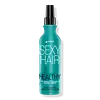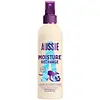What's inside
What's inside
 Key Ingredients
Key Ingredients

 Benefits
Benefits

 Concerns
Concerns

 Ingredients Side-by-side
Ingredients Side-by-side

Water
Skin ConditioningQuaternium-18
Amodimethicone
Polysorbate 20
EmulsifyingPropylene Glycol
HumectantEthylhexylglycerin
Skin ConditioningMethyl Gluceth-10
EmulsifyingTrideceth-12
EmulsifyingParfum
MaskingIsopropyl Alcohol
SolventPanthenol
Skin ConditioningDisodium EDTA
Cetrimonium Chloride
AntimicrobialCysteine
AntioxidantHydrolyzed Wheat Protein
Skin ConditioningWheat Amino Acids
Skin ConditioningHydrolyzed Wheat Starch
Skin ConditioningAcacia Dealbata Flower Extract
Skin ConditioningGlycerin
HumectantMoonstone Extract
Skin ConditioningCitric Acid
BufferingBenzophenone-4
UV AbsorberPhenoxyethanol
PreservativePotassium Sorbate
PreservativeButylparaben
MaskingEthylparaben
PreservativeMethylparaben
PreservativePropylparaben
PreservativeSodium Benzoate
MaskingCitronellol
PerfumingLimonene
PerfumingLinalool
PerfumingWater, Quaternium-18, Amodimethicone, Polysorbate 20, Propylene Glycol, Ethylhexylglycerin, Methyl Gluceth-10, Trideceth-12, Parfum, Isopropyl Alcohol, Panthenol, Disodium EDTA, Cetrimonium Chloride, Cysteine, Hydrolyzed Wheat Protein, Wheat Amino Acids, Hydrolyzed Wheat Starch, Acacia Dealbata Flower Extract, Glycerin, Moonstone Extract, Citric Acid, Benzophenone-4, Phenoxyethanol, Potassium Sorbate, Butylparaben, Ethylparaben, Methylparaben, Propylparaben, Sodium Benzoate, Citronellol, Limonene, Linalool
Water
Skin ConditioningGlycerin
HumectantPhenoxyethanol
PreservativeAmodimethicone
PPG-2 Methyl Ether
PerfumingPEG-40 Hydrogenated Castor Oil
EmulsifyingBenzyl Alcohol
PerfumingParfum
MaskingPolyquaternium-11
Polysorbate 80
EmulsifyingDisodium EDTA
Ethylhexylglycerin
Skin ConditioningAminomethyl Propanol
BufferingCitric Acid
BufferingTrideceth-12
EmulsifyingCetrimonium Chloride
AntimicrobialLimonene
PerfumingSodium Benzoate
MaskingAlpha-Isomethyl Ionone
PerfumingLinalool
PerfumingCaprylyl Glycol
EmollientMacadamia Ternifolia Seed Oil
EmollientHexyl Cinnamal
PerfumingTocopherol
AntioxidantWater, Glycerin, Phenoxyethanol, Amodimethicone, PPG-2 Methyl Ether, PEG-40 Hydrogenated Castor Oil, Benzyl Alcohol, Parfum, Polyquaternium-11, Polysorbate 80, Disodium EDTA, Ethylhexylglycerin, Aminomethyl Propanol, Citric Acid, Trideceth-12, Cetrimonium Chloride, Limonene, Sodium Benzoate, Alpha-Isomethyl Ionone, Linalool, Caprylyl Glycol, Macadamia Ternifolia Seed Oil, Hexyl Cinnamal, Tocopherol
Ingredients Explained
These ingredients are found in both products.
Ingredients higher up in an ingredient list are typically present in a larger amount.
This water-soluble silicone is used for its hydrating and softening properties. It is used to add a silky feel to skincare products and has great benefits for haircare.
In haircare, this ingredient:
- Adds shine
- Protects color
- Offers thermal protection
- Boosts hair strength
- Does not build up as easily
This ingredient is a preservative, antimicrobial, and emulsifier. It is often used in cosmetics for its ability to cleanse, condition, and reduce static.
Cetrimonium chloride is a quaternary ammonium salt, meaning it has a water-soluble structure.
Citric Acid is an alpha hydroxy acid (AHA) naturally found in citrus fruits like oranges, lemons, and limes.
Like other AHAs, citric acid can exfoliate skin by breaking down the bonds that hold dead skin cells together. This helps reveal smoother and brighter skin underneath.
However, this exfoliating effect only happens at high concentrations (20%) which can be hard to find in cosmetic products.
Due to this, citric acid is usually included in small amounts as a pH adjuster. This helps keep products slightly more acidic and compatible with skin's natural pH.
In skincare formulas, citric acid can:
While it can provide some skin benefits, research shows lactic acid and glycolic acid are generally more effective and less irritating exfoliants.
Most citric acid used in skincare today is made by fermenting sugars (usually from molasses). This synthetic version is identical to the natural citrus form but easier to stabilize and use in formulations.
Read more about some other popular AHA's here:
Learn more about Citric AcidDisodium EDTA plays a role in making products more stable by aiding other preservatives.
It is a chelating agent, meaning it neutralizes metal ions that may be found in a product.
Disodium EDTA is a salt of edetic acid and is found to be safe in cosmetic ingredients.
Learn more about Disodium EDTAEthylhexylglycerin (we can't pronounce this either) is commonly used as a preservative and skin softener. It is derived from glyceryl.
You might see Ethylhexylglycerin often paired with other preservatives such as phenoxyethanol. Ethylhexylglycerin has been found to increase the effectiveness of these other preservatives.
Glycerin is already naturally found in your skin. It helps moisturize and protect your skin.
A study from 2016 found glycerin to be more effective as a humectant than AHAs and hyaluronic acid.
As a humectant, it helps the skin stay hydrated by pulling moisture to your skin. The low molecular weight of glycerin allows it to pull moisture into the deeper layers of your skin.
Hydrated skin improves your skin barrier; Your skin barrier helps protect against irritants and bacteria.
Glycerin has also been found to have antimicrobial and antiviral properties. Due to these properties, glycerin is often used in wound and burn treatments.
In cosmetics, glycerin is usually derived from plants such as soybean or palm. However, it can also be sourced from animals, such as tallow or animal fat.
This ingredient is organic, colorless, odorless, and non-toxic.
Glycerin is the name for this ingredient in American English. British English uses Glycerol/Glycerine.
Learn more about GlycerinLimonene is a fragrance that adds scent and taste to a formulation.
It's found in the peel oil of citrus fruits and other plants such as lavender and eucalyptus. The scent of limonene is generally described as "sweet citrus".
Limonene acts as an antioxidant, meaning it helps neutralize free radicals.
When exposed to air, oxidized limonene may sensitize the skin. Because of this, limonene is often avoided by people with sensitive skin.
The term 'fragrance' is not regulated in many countries. In many cases, it is up to the brand to define this term. For instance, many brands choose to label themselves as "fragrance-free" because they are not using synthetic fragrances. However, their products may still contain ingredients such as essential oils that are considered a fragrance.
Learn more about LimoneneLinalool is a fragrance and helps add scent to products. It's derived from common plants such as cinnamon, mint, citrus, and lavender.
Like Limonene, this ingredient oxidizes when exposed to air. Oxidized linalool can cause allergies and skin sensitivity.
This ingredient has a scent that is floral, spicy tropical, and citrus-like.
Learn more about LinaloolParfum is a catch-all term for an ingredient or more that is used to give a scent to products.
Also called "fragrance", this ingredient can be a blend of hundreds of chemicals or plant oils. This means every product with "fragrance" or "parfum" in the ingredients list is a different mixture.
For instance, Habanolide is a proprietary trade name for a specific aroma chemical. When used as a fragrance ingredient in cosmetics, most aroma chemicals fall under the broad labeling category of “FRAGRANCE” or “PARFUM” according to EU and US regulations.
The term 'parfum' or 'fragrance' is not regulated in many countries. In many cases, it is up to the brand to define this term.
For instance, many brands choose to label themselves as "fragrance-free" because they are not using synthetic fragrances. However, their products may still contain ingredients such as essential oils that are considered a fragrance by INCI standards.
One example is Calendula flower extract. Calendula is an essential oil that still imparts a scent or 'fragrance'.
Depending on the blend, the ingredients in the mixture can cause allergies and sensitivities on the skin. Some ingredients that are known EU allergens include linalool and citronellol.
Parfum can also be used to mask or cover an unpleasant scent.
The bottom line is: not all fragrances/parfum/ingredients are created equally. If you are worried about fragrances, we recommend taking a closer look at an ingredient. And of course, we always recommend speaking with a professional.
Learn more about ParfumPhenoxyethanol is a preservative that has germicide, antimicrobial, and aromatic properties. Studies show that phenoxyethanol can prevent microbial growth. By itself, it has a scent that is similar to that of a rose.
It's often used in formulations along with Caprylyl Glycol to preserve the shelf life of products.
Sodium Benzoate is a preservative. It's used in both cosmetic and food products to inhibit the growth of mold and bacteria. It is typically produced synthetically.
Both the US FDA and EU Health Committee have approved the use of sodium benzoate. In the US, levels of 0.1% (of the total product) are allowed.
Sodium benzoate works as a preservative by inhibiting the growth of bacteria inside of cells. It prevents the cell from fermenting a type of sugar using an enzyme called phosphofructokinase.
It is the salt of benzoic acid. Foods containing sodium benzoate include soda, salad dressings, condiments, fruit juices, wines, and snack foods.
Studies for using ascorbic acid and sodium benzoate in cosmetics are lacking, especially in skincare routines with multiple steps.
We always recommend speaking with a professional, such as a dermatologist, if you have any concerns.
Learn more about Sodium BenzoateWe don't have a description for Trideceth-12 yet.
Water. It's the most common cosmetic ingredient of all. You'll usually see it at the top of ingredient lists, meaning that it makes up the largest part of the product.
So why is it so popular? Water most often acts as a solvent - this means that it helps dissolve other ingredients into the formulation.
You'll also recognize water as that liquid we all need to stay alive. If you see this, drink a glass of water. Stay hydrated!
Learn more about Water